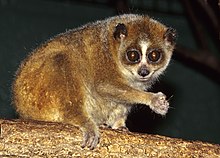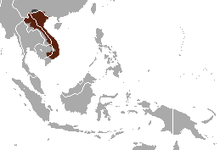Our website is made possible by displaying online advertisements to our visitors.
Please consider supporting us by disabling your ad blocker.
Pygmy slow loris
| Pygmy slow loris | |
|---|---|

| |
| Scientific classification | |
| Domain: | Eukaryota |
| Kingdom: | Animalia |
| Phylum: | Chordata |
| Class: | Mammalia |
| Order: | Primates |
| Suborder: | Strepsirrhini |
| Family: | Lorisidae |
| Subfamily: | Lorinae |
| Genus: | Xanthonycticebus Nekaris & Nijman, 2022[3] |
| Species: | X. pygmaeus
|
| Binomial name | |
| Xanthonycticebus pygmaeus (Bonhote, 1907)
| |

| |
| Pygmy slow loris range | |
| Synonyms[2] | |
| |
The pygmy slow loris (Xanthonycticebus pygmaeus) is a species of slow loris found east of the Mekong River in Vietnam, Laos, eastern Cambodia, and China. It occurs in a variety of forest habitats, including tropical dry forests, semi-evergreen, and evergreen forests. It was originally classified within Nycticebus until it was transferred to the genus Xanthonycticebus in 2022.[3] Two species are recognised, the northern pygmy loris X. intermedius from northern Vietnam, Laos and China and the southern pygmy loris X. pygmaeus from southern Vietnam, Laos and Cambodia.[4] The animal is nocturnal and arboreal, crawling along branches using slow movements in search of prey. Unlike other primates, it does not leap. It lives together in small groups usually with one or two offspring. An adult can grow to around 19 to 23 cm (7.5 to 9.1 in) long and has a very short tail. It weighs about 450 g (1.0 lb). Its diet consists of fruits, insects, small fauna, tree sap, and floral nectar. The animal has a toxic bite, which it gets by licking a toxic secretion from glands on the inside of its elbows. The teeth in its lower jaw form a comb-like structure called a toothcomb that is used for scraping resin from tree bark.
The pygmy slow loris mates once every 12–18 months and has one or two offspring after an average gestation period of six months. For the first few days, the young loris clings to the belly of its mother. The offspring will be nursed for an average of 4.5 months, but weaning can sometimes take up to 8 months. The female reaches sexual maturity at about 9 months, while the male reaches maturity by about 18–20 months. The pygmy slow loris is seasonally fertile during the months of July and October. Chemical signals play a role in the reproductive behavior of female pygmy slow lorises. Urine scent markings have a strong characteristic odor and are used to communicate information about social relationships.
The habitat of the pygmy slow loris in Vietnam was greatly reduced due to extensive burning, clearing, and defoliating of forests during the Vietnam War. Extensive hunting for traditional medicines is currently putting severe pressure on Cambodian populations. The pygmy slow loris is seriously threatened by hunting, trade, and habitat destruction; consequently, it is listed in Appendix I of the Convention on International Trade in Endangered Species of Wild Fauna and Flora (CITES), and in 2020 the International Union for Conservation of Nature (IUCN) classified it as endangered.
- ^ Blair, M.; Nadler, T.; Ni, O.; Samun, E.; Streicher, U.; Nekaris, K.A.I. (2021). "Nycticebus pygmaeus". IUCN Red List of Threatened Species. 2021: e.T14941A198267330. doi:10.2305/IUCN.UK.2021-2.RLTS.T14941A198267330.en. Retrieved 12 November 2021.
- ^ a b Cite error: The named reference
CITESwas invoked but never defined (see the help page). - ^ a b K. Anne-Isola Nekaris; Vincent Nijman (2022). "A new genus name for pygmy lorises, Xanthonycticebus gen. nov. (Mammalia, primates)". Zoosystematics and Evolution. 98: 87–92. doi:10.3897/zse.98.81942. S2CID 247649999.
- ^ Blair, Mary E.; Cao, Giang T. H.; López-Nandam, Elora H.; Veronese-Paniagua, Daniel A.; Birchette, Mark G.; Kenyon, Marina; Md-Zain, Badrul M.; Munds, Rachel A.; Nekaris, K. Anne-Isola; Nijman, Vincent; Roos, Christian; Thach, Hoàng M.; Sterling, Eleanor J.; Le, Minh D. (3 March 2023). "Molecular Phylogenetic Relationships and Unveiling Novel Genetic Diversity among Slow and Pygmy Lorises, including Resurrection of Xanthonycticebus intermedius". Genes. 14 (3): 643. doi:10.3390/genes14030643. ISSN 2073-4425. PMC 10048081. PMID 36980915.
Previous Page Next Page



